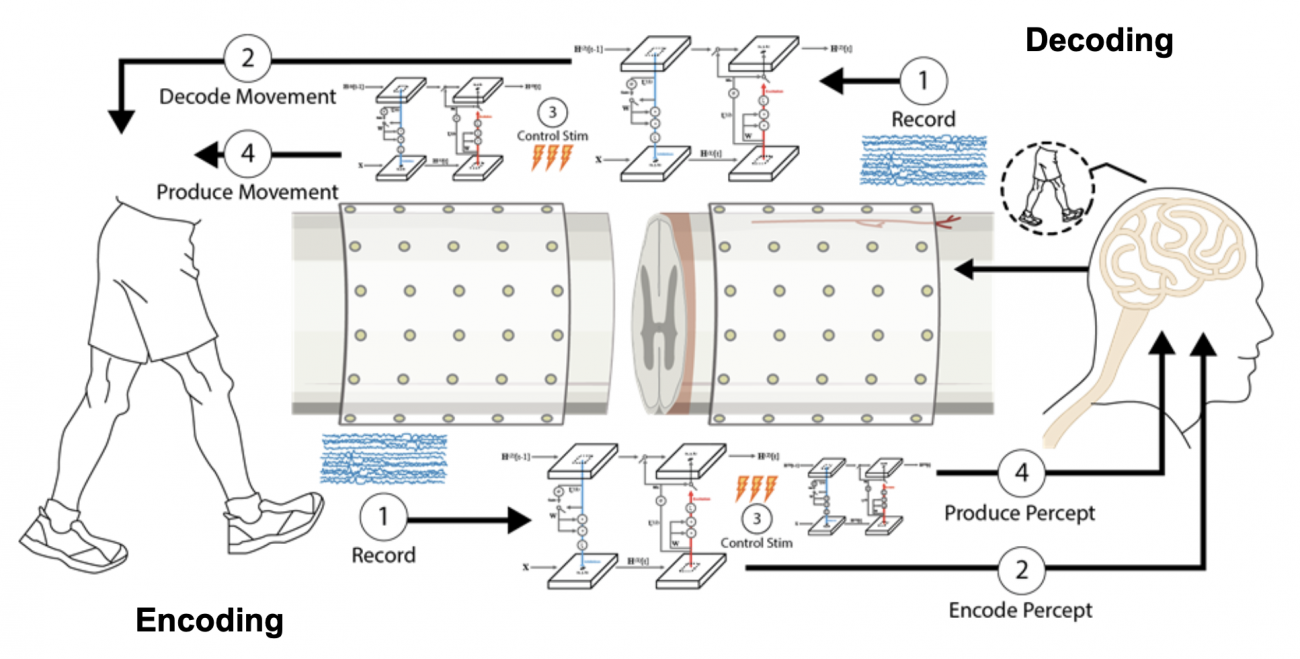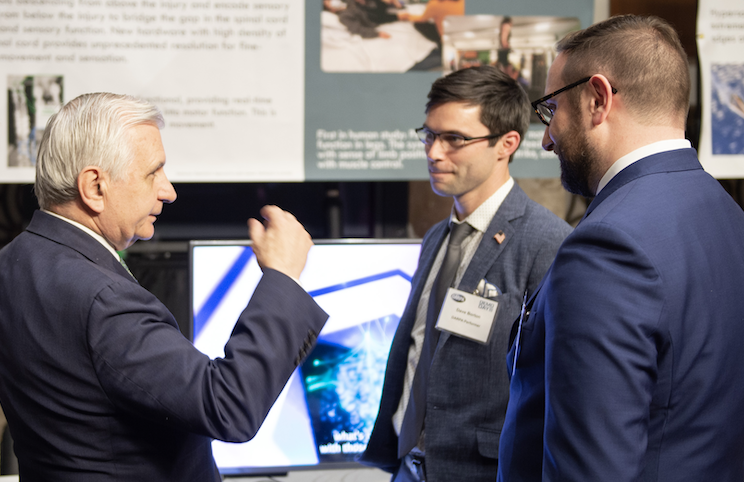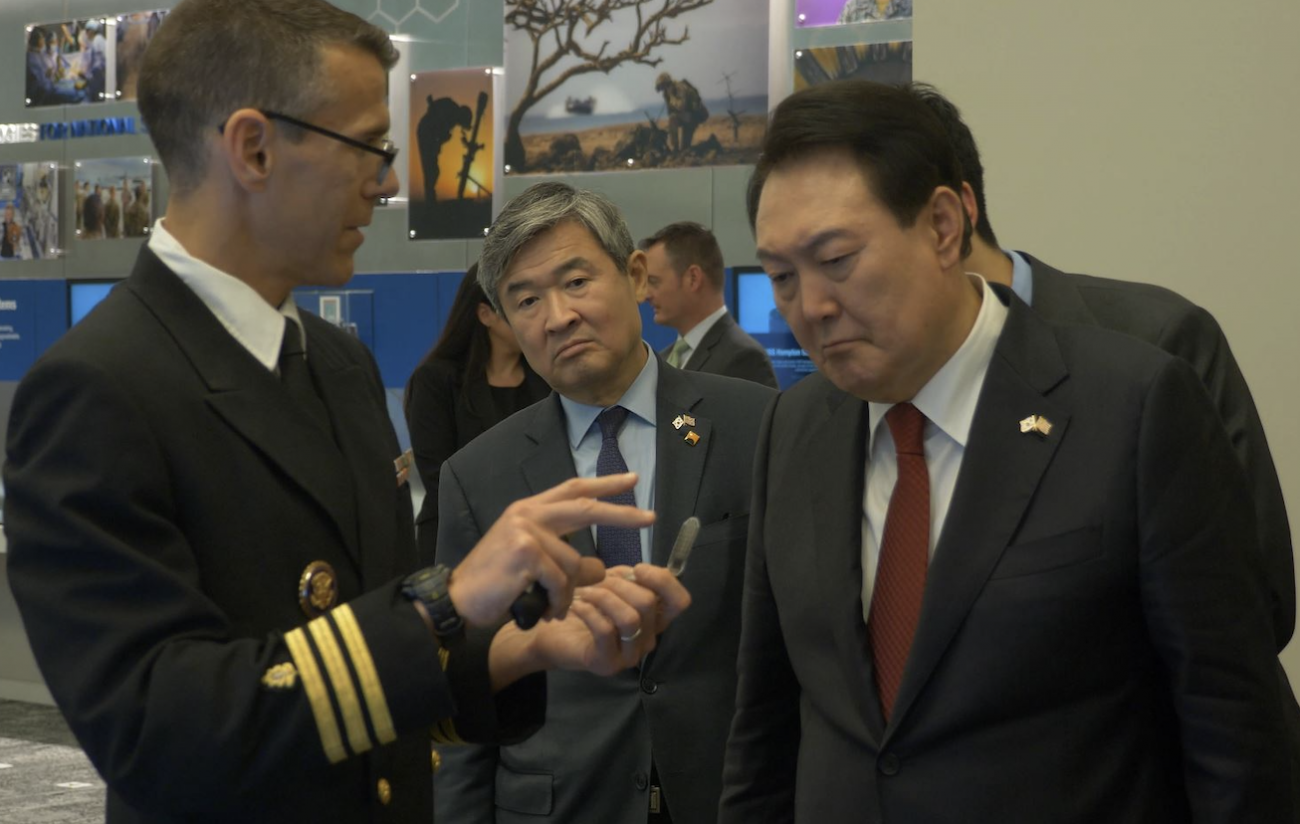Picture a middle school science fair full of card tables, experiments, posters and participants, with spectators and judges walking around amidst the exhibits, taking it all in.
That’s what two back-to-back days in April were like for Carney-affiliated faculty member and associate professor of engineering David Borton. But, instead of a school gym, the venue was the Dirksen Senate Office Building in Washington, D.C. The spectators and judges were senators, congresspeople and staffers. The participants were funded by the Defense Advanced Research Projects Agency (DARPA) to solve vital problems, like how to restore lower limb mobility, sensation and bladder function in wounded veterans.
Borton, together with Carney-affiliated faculty member Jared Fridley, a neurosurgeon and director of Spine Surgery Outcomes Research Laboratory at The Warren Alpert Medical School, presented groundbreaking research on this topic to the U.S. Senate on April 18 and to the U.S. House of Representatives on April 19 for DARPA Demo Day, an initiative designed to help politicians learn more about the work DARPA supports. Borton and Fridley were one of only 10 groups chosen to do so from DARPA’s portfolio of hundreds of projects.
“Our goal was to share our excitement for how well our research project is going,” said Borton, who earned his Ph.D. in biomedical engineering at Brown, followed by a postdoc in Switzerland. He returned to Brown and Carney in 2014, where he embarked on his first DARPA-funded project in 2015, developing devices that interface between the brain and spine. In 2018, DARPA became interested in the spinal cord interfacing research that Borton’s lab had developed. This ignited an exciting conversation: could Borton’s lab move from mapping sensory perception to actually “bridging the gap” in spinal cord injury, creating a technology that could reconnect the brain to the dormant spinal circuits below an injury site, thereby restoring movement, sensation and function?
Five years later, Borton and Fridley, who came onboard as the project’s lead clinical investigator, are much closer to an answer. Their Intelligent Spine Interface implant is in clinical trials with participants from the New England region, and co-supported by the Providence VA Medical Center.
“Paralyzed veterans currently do not have clinically available tools to improve recovery after spinal cord injury other than physical rehabilitation,” Fridley explained. “Those with severe injuries, not able to move or feel their extremities, have a low likelihood of significant recovery. After approximately one year of rehabilitation, the chance of recovery drops significantly.”

"Their needs are also quite diverse,” Borton added. “Where our ISI implant is unique is that we are building a bi-directional interface that has smarts on board. We have advanced chips on the spinal system that can be reprogrammed and adapted over time to address the diverse needs of spinal cord injury patients. At the same time, this device functions as a research platform. To my knowledge, no other groups are recording from the spinal cord and trying to interpret those signals. It's a big decoding challenge, but we want to take that on.”
The clinical trial process for the ISI implant is complex and highly collaborative. Fridley identifies and recruits a participant who could benefit from the implant. While he performs the surgery to install the device at Rhode Island Hospital, Borton and his team help guide the placement of electrode arrays. After two days of surgical recovery, the participant and researchers embark on two weeks of trials in a one-of-a-kind clinical facility built specifically for this research at the The Center for Innovative Neurotechnology for Neural Repair (CINNR). Each day, Borton and his team run a series of experiments with the participant. These experiments are done in tandem with Carney-affiliated faculty member Thomas Serre’s team. All of them are overseen by a member of Fridley’s neurosurgical team to ensure constant care. In some cases, family members of the participant play a role in the process.
For more glimpses of the ISI implant and the one-of-a-kind clinical facility at CINNR, check out this video.
According to Borton, Carney has been integral to the ISI implant’s advance to the clinical trial phase. The Institute’s mission to promote discovery in brain science by creating an outstanding collaborative environment has fostered a key working relationship between Borton and Serre, who directs the Carney Center for Computation and Visualization. Serre’s deep expertise in neural network design, especially in building computational models inspired from human biology, made his team ideal to design the model that provides the implant’s stable mapping between electrical stimulation of the spinal cord and the participant’s muscles and sensations.
“The proximity of my laboratory to Thomas Serre's has been foundational,” Borton said. “My team sits next to his team, and they’ve become best of friends.” During the two-week trials at CINNR, he explained, “Thomas’s team was there 24 hours a day with my team, troubleshooting all the little things that came up. It felt so natural, like we were all one team as opposed to two distinct groups. That wouldn’t have happened if they didn’t know each other so well.”

At DARPA Demo Day, Borton and Fridley got the chance to share samples of the implant, a video loop of experiments with trial participants, and a poster of the project’s aims with staffers from multiple senators and congresspeople, as well as with Rhode Island Senator and Chairman of the Senate Armed Services committee Jack Reed, who sets the budgetary priorities for DARPA through the National Defense Authorization Act. Fridley, Borton and Reed were joined by DARPA’s Director Stefanie Tompkins, who holds a Ph.D. from Brown.
“We all just started chatting about how wonderful Brown is,” Borton said of that meeting. “Senator Reed remembered fondly talking to [Brown Institute for Brain Science founding director] John Donoghue about the idea that we could take information from the brain and control prosthetic limbs. I think he really does have a good handle on what Rhode Island can continue to excel at in the neurotechnology and brain sciences space. I was excited to share Brown’s recent growth in brain science and engineering with the senator.”
Although Borton and Fridley weren’t aware of it at the time, their DARPA Demo generated not just national interest, but international interest as well. A week later, DARPA shared that their demo had been part of a private presentation to President Yoon Suk Yeol of South Korea during his visit to the U.S.
